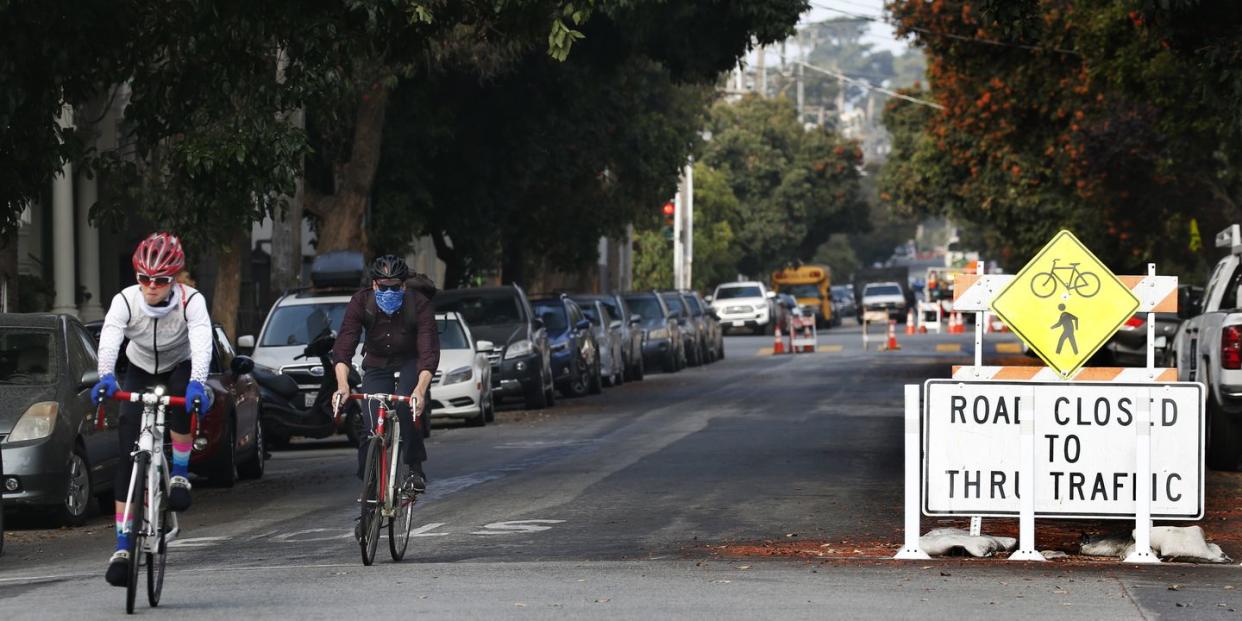After Contentious Municipal Meeting, San Francisco Has a Win Preserving Slow Streets

After a contentious municipal meeting in San Francisco on Tuesday, bike advocates are celebrating a win for Slow Streets at the San Francisco Municipal Transportation Agency (SFMTA) board meeting. As of late last night, San Francisco’s shared streets program—AKA Slow Streets—was made permanent. This included the hotly debated Lake Street, which also added an even lower speed limit of 15mph.
“Tonight at 10:31 p.m., the SFMTA Board, in a historic decision, declared Slow Lake Street to be a permanent part of San Francisco’s new Slow Streets network," tweeted The Friends of Slow Lake Street early Wednesday morning.
Tonight at 10:31 p.m., the SFMTA Board, in a historic decision, declared Slow Lake Street to be a permanent part of San Francisco’s new Slow Streets network. It also lowered the goals to 15 mph and 1,000 cars a day. pic.twitter.com/N1h5WzPLsV
— Friends of Slow Lake Street ❤️ (@SlowLakeStreet) December 7, 2022
The Slow Streets program is being celebrated as one of the biggest municipal wins to come out of the COVID-19 pandemic, which prompted many cities to lean into better cycling and walking infrastructure to encourage outdoor activity and provide easier, safer transportation alternatives when riding public transit was unsafe for many.
San Francisco’s 14 Slow Streets made people safer. According to The San Francisco Chronicle, “A new analysis of traffic crashes on 14 Slow Streets, that the SFMTA’s board will consider making permanent at Tuesday’s meeting, shows that crashes on those streets have dropped by 61 percent since their implementation, compared to 20% citywide.”
JUST IN: A new analysis of traffic crashes on 14 Slow Streets, that the SFMTA’s board will consider making permanent at Tuesday’s meeting, shows that crashes on those streets have dropped by 61% since their implementation, compared to 20% citywide. https://t.co/ep5Yim7X35
— San Francisco Chronicle (@sfchronicle) December 6, 2022
Bike advocacy groups like StreetsblogSF were calling for members of the public to show up to the municipal meeting that would determine the fate of San Francisco’s Slow Streets, and the public certainly dialed in. The meeting floor opened for public commentary at 3 p.m., and it wasn’t over for seven hours.
Of course, not all the comments were pro-bike. Those who want faster commutes at all costs—including using Lake Street when a nearby road was congested during rush hour—tried to abolish certain Slow Streets. As Streetsblog tweeted:
I have now heard some version of "please let me drive really fast on Lake Street" over 100 times. Also, San Francisco isn't Amsterdam. pic.twitter.com/jDDJYqupRN
— Streetsblog SF (@StreetsblogSF) December 7, 2022
Bike advocates and some advocates from the fire department also found themselves on opposing sides of a controversial rule: Known as the “26-foot rule,” a very specific point in the fire code is blocking many of the infrastructure improvements needed to create safer streets for pedestrians and cyclists. StreetsblogSF was concerned that the old rule would cause the end of Slow Streets, but luckily, it wasn’t an issue.
Hopefully, the permanent Slow Street model will be adapted in more cities where bike programs were spurred on by the pandemic. If your city has had slow streets or new bike paths or lanes added since 2020, it may be worth checking with your town council to see if those additions are permanent. And if they’re not, try reaching out to local cycling advocacy groups to see what it would take to ensure that your city maintains the bike-friendly gains it has made so far.
You Might Also Like

